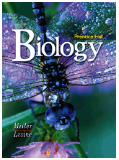BIOLOGY
by Miller & Levine
[complete Table of Contents]

|
Use the pull-down menu to jump to any of the Book's 40 Chapters: |
Additional Resources:
How can you tell how old a plant's root is? Click Here for an answer.
BackYard
Plants!
A web site explain how roots, stems, and leaves actually work.
![]() Chapter 23
Chapter 23 ![]()
Roots, Stems, and Leaves

| Hot Links | |
| Take it to the Net | Teaching Links |
What are Web Codes? |
Web
Codes for Chapter 23: |
![]()
Section
23-1: Specialized Tissues in Plants
![]() The three principal
organs in seed plants are roots, stems, and leaves.
The three principal
organs in seed plants are roots, stems, and leaves.
Plants consist of three tissue systems: dermal tissue, vascular tissue,
and ground tissue.
 Meristematic tissue is the only plant
tissue that produces new cells by mitosis.
Meristematic tissue is the only plant
tissue that produces new cells by mitosis.
 Vascular tissue contains several different
cell types. Xylem consists of tracheids and vessel elements, and phloem
consists of sieve tube elements and companion cells.
Vascular tissue contains several different
cell types. Xylem consists of tracheids and vessel elements, and phloem
consists of sieve tube elements and companion cells.
Section
23-2: Roots
 The two main types of roots are taproots,
found mainly in dicots, and fibrous roots, found mainly in monocots.
The two main types of roots are taproots,
found mainly in dicots, and fibrous roots, found mainly in monocots.
 A mature root has an outside layer of
epidermal cells and a central cylinder of vascular tissue separated by
a large area of ground tissue called the cortex.
A mature root has an outside layer of
epidermal cells and a central cylinder of vascular tissue separated by
a large area of ground tissue called the cortex.
 Roots anchor a plant in the ground and
absorb water and dissolved nutrients from the soil.
Roots anchor a plant in the ground and
absorb water and dissolved nutrients from the soil.
Section
23-3: Stems
 Stems have three important functions:
they produce leaves, branches, and flowers; they hold leaves up in the
sunlight; and they transport various substances between roots and leaves.
Stems have three important functions:
they produce leaves, branches, and flowers; they hold leaves up in the
sunlight; and they transport various substances between roots and leaves.
 In monocots, vascular bundles are scattered
throughout the stem. In dicots and most gymnosperms, vascular bundles
are arranged in a cylinder.
In monocots, vascular bundles are scattered
throughout the stem. In dicots and most gymnosperms, vascular bundles
are arranged in a cylinder.
 In all seed plants, primary growth of
stems is produced by cell divisions in the apical meristem.
In all seed plants, primary growth of
stems is produced by cell divisions in the apical meristem.
 In conifers and dicots, secondary growth
takes place in lateral meristematic tissues called the vascular cambium
and cork cambium.
In conifers and dicots, secondary growth
takes place in lateral meristematic tissues called the vascular cambium
and cork cambium.
Section
23-4: Leaves
 The structure of a leaf is optimized
for absorbing light and carrying out photosynthesis.
The structure of a leaf is optimized
for absorbing light and carrying out photosynthesis.
 Plants keep their stomata open just enough
to allow photosynthesis to take place, but not so much that they lose
an excessive amount of water.
Plants keep their stomata open just enough
to allow photosynthesis to take place, but not so much that they lose
an excessive amount of water.
Section
23-5: Transport in Plants
 Root pressure, capillary action, and
transpiration work together to move water through the xylem tissue of
even the largest plant.
Root pressure, capillary action, and
transpiration work together to move water through the xylem tissue of
even the largest plant.
 When nutrients are pumped into or removed
from the phloem system, the change in concentration causes a movement
of water in that same direction. As a result, phloem is able to move nutrients
in either direction to meet the nutritional needs of the plant.
When nutrients are pumped into or removed
from the phloem system, the change in concentration causes a movement
of water in that same direction. As a result, phloem is able to move nutrients
in either direction to meet the nutritional needs of the plant.